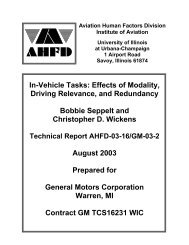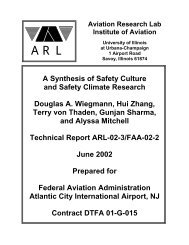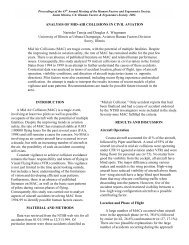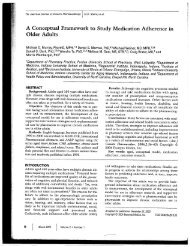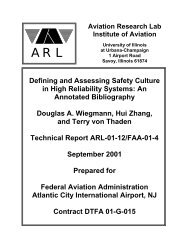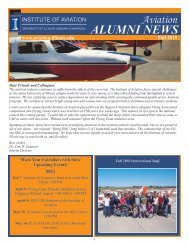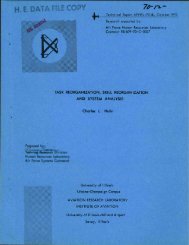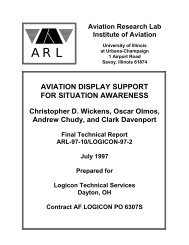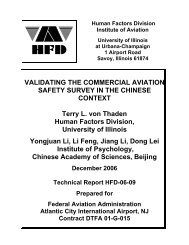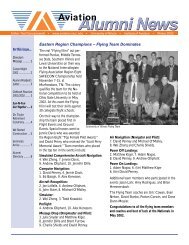Usability Questionnaire Results - Institute of Aviation - University of ...
Usability Questionnaire Results - Institute of Aviation - University of ...
Usability Questionnaire Results - Institute of Aviation - University of ...
Create successful ePaper yourself
Turn your PDF publications into a flip-book with our unique Google optimized e-Paper software.
displays. This suggests that the larger contour did have some ability to attract the user’sattention to it first. The decreased performance on the detection and acknowledging task in thecontour group may be due to participants employing a strategy to find the worst violation first.Instead <strong>of</strong> acknowledging the first violation detected, they may have been waiting until the worstviolation had been detected and acknowledged that violation first.One explanation for the cause <strong>of</strong> this strategy <strong>of</strong> acknowledging the largest contour firstis the use <strong>of</strong> highlighting. The intent <strong>of</strong> highlighting is to attract attention to an area to aid insearch and identification <strong>of</strong> targets, and color can be used to do this (Fisher & Tan, 1989).Although this highlighting feature did not appear to <strong>of</strong>fset the cost in time seen between thetabular display and the integrated display for detecting and acknowledging, the color contoursdid appear to draw and focus attention on problems in the power grid.Color contouring led to a surprising finding when examining the task-order violations.As described in the results, a task-order violation occurred when a participant attempted to solvefor voltage violations before acknowledging them all first. This equates to a failure in thedetection task. The occurrence <strong>of</strong> a task-order error was virtually non-existent for the tabular andone-line groups, but occurred almost once per subject for the experiment in the contour group.This observed effect may be due to attentional tunneling by participants. Mentionedpreviously, some participants in the contour condition did detect and acknowledge the worstviolation first. Participants using this strategy may have been too eager to acknowledge theworst violation first. This may be due to the fact that the worst violation for each trial had thelargest contour, and more attention was drawn to it due to its high salience. This type <strong>of</strong>attentional tunneling may prevent users from recognizing that other voltage violations exist andthey instead go on to solve for the worst contour. Moray and Rotenberg (1989) found a similarbehavior in an experiment that simulated a process control task in a thermal hydraulic system.Their results suggested that operators prefer to work on only one fault at a time and that this‘cognitive lock-up’ hinders recognition <strong>of</strong> further faults. This could also explain why colorcontours were found to incur a cost in time only when acknowledging for multiple trials. Ifparticipants are indeed sometimes trying to solve before acknowledging because, as Moray andRotenberg suggested, they prefer to work on only one fault at a time, then the acknowledgingtime would increase as well, which was observed in this experiment. The acknowledging timewould increase because the simulation would not allow the solving task to commence until allviolations were acknowledged. A step would be added where it would be necessary to recognizethe error committed, and then go back to the acknowledging task.Color contours, however, could prove to be more useful in larger power systems. The30-bus system used in this experiment is relatively small and bus information management isfairly simple. Power systems with hundreds <strong>of</strong> buses such as real life power grids would bemuch more difficult in terms <strong>of</strong> information management. Contours in these larger powersystems may help to pinpoint the most serious problem areas for power system engineers toexamine more closely. Contours could be useful if the task for a user is to find the worstviolation first since it was found that the largest contour did have some ability to attract theuser’s attention to it first. Another possibility <strong>of</strong> how contours could enhance performance is indisplays that are more dynamically changing. The faults in this experiment were meant tosimulate problems that occur when lightning strikes a power grid. This created an instantaneous31




